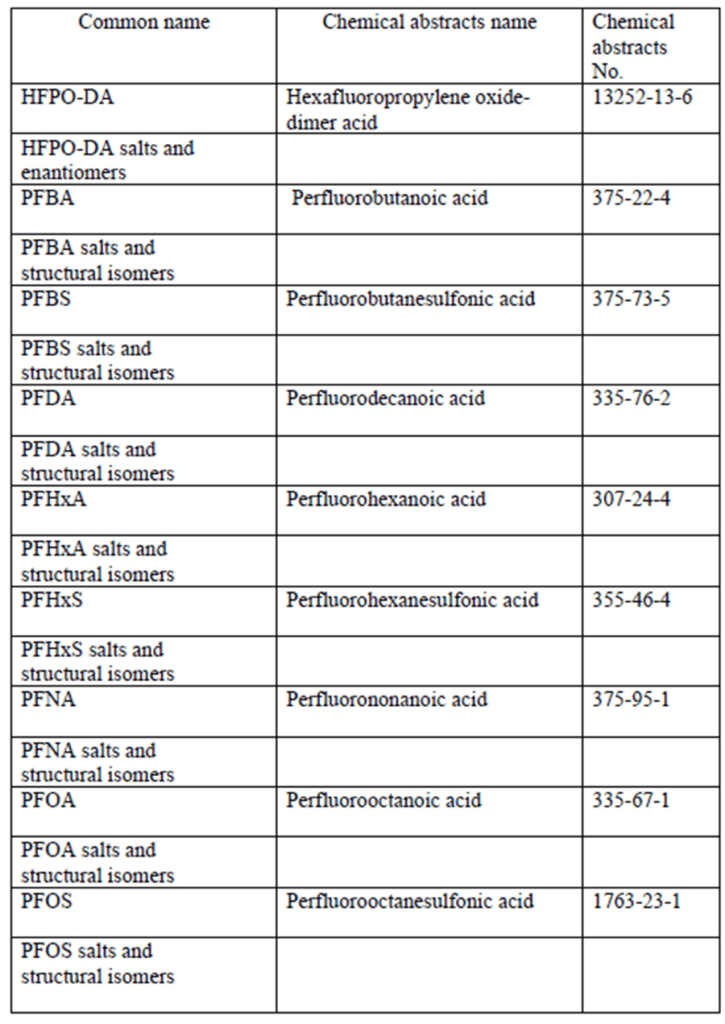


In response to its PFAS Strategic Roadmap, the Environmental Protection Agency (EPA) initiated two regulatory actions under the Resource Conservation and Recovery Act (RCRA) to tackle PFAS pollution. Once implemented, these measures will empower federal and state agencies with advanced tools for PFAS remediation.
The initial proposed regulation intends to designate specific PFAS as “hazardous constituents” within RCRA’s framework, making them subject to detailed scrutiny and cleanup actions at sites handling hazardous waste.
The second proposed rule aims to affirm that new contaminants, including certain PFAS that are not currently classified as “hazardous wastes” yet align with the definition of “hazardous waste” in RCRA section 1004(5), should be managed equivalently to traditional hazardous wastes in the context of corrective actions. Listing these PFAS as RCRA hazardous constituents does not make them, or the wastes containing them, RCRA hazardous wastes.

On February 8, 2024, the EPA proposed to add nine PFAS compounds to the list of “hazardous constituents” to be considered “in RCRA facility assessments and, where necessary, further investigation and cleanup through the RCRA corrective action process.” Appendix VIII to Part 261 – Hazardous Constituents shown at right.
If finalized, this hazardous constituent listing would form part of the basis for any future action the EPA may take to list these substances as hazardous waste.
EPA’s criteria for listing substances as hazardous constituents under RCRA require that they have been shown in scientific studies to have toxic, carcinogenic, mutagenic, or teratogenic effects on humans or other life forms.
Entities potentially affected by the proposed rule include hazardous waste treatment, storage, and disposal facilities (TSDFs) with solid waste management units (SWMUs) that have released or could release any of the PFAS proposed to be listed as RCRA hazardous constituents. EPA has identified 1,740 such facilities, which could be subject to additional corrective action requirements. “Waste Management and Remediation Services” had the highest number of facilities (359) with a high likelihood of handling PFAS.
The primary goal of the suggested amendment is to update 40 CFR 264.101 so that it accurately mirrors the requirements for corrective action cleanups at hazardous waste Treatment, Storage, and Disposal Facilities (TSDFs) as specified by RCRA sections 3004(u) and (v). The modifications are designed to clarify that the management of hazardous waste releases, including those not categorized as hazardous under current regulations but fitting the broader definition in RCRA section 1004(5), should adhere to the established protocols for hazardous waste under the corrective action program. Focusing on Per- and Polyfluoroalkyl Substances (PFAS), this regulatory action is a crucial part of the EPA’s PFAS Strategic Roadmap.
Should this proposed regulation be adopted, it would mean that PFAS would be specifically included as hazardous constituents to be considered during facility assessments and, where necessary, further investigation and cleanup under the RCRA corrective action process at hazardous waste TSDFs.
The proposed regulation states that “solid waste disposal facilities, such as those for municipal waste or construction and demolition debris, would not be subject to RCRA corrective action requirements unless they also function as hazardous waste TSDFs.”
Subtitle D of RCRA covers non-hazardous solid waste management, including municipal solid waste landfills, which are subject to different regulations than hazardous waste facilities (regulated under Subtitle C).
Although the recent proposal by the EPA to revise RCRA does not aim at mandating corrective actions at municipal solid waste (MSW) landfills, it sets the stage for probable future amendments under Subtitle C that might classify certain PFAS-containing waste streams, currently considered non-hazardous, as hazardous waste (e.g., listed or characteristic wastes).
While it is premature to predict the impact of future hazardous waste regulations on MSW landfills, it is appropriate to begin collecting information on PFAS waste and assessing potential effects now. Landfills that have implemented special waste review programs (for example, for non-hazardous industrial wastes like wastewater treatment sludge) are advised to expand their waste characterization efforts within these programs to include requests for data on the presence and concentration of the nine PFAS constituents highlighted in the proposed RCRA rule. Additionally, landfills without such review programs are encouraged to consider establishing them.
Additional Resources/Legislation:
About the Authors: Connect with our authors and experts at
 Jeff Marshall, PE, is a Vice President of SCS Engineers, Environmental Services Practice Leader for SCS offices in the Mid-Atlantic region, and our National Expert on Emerging Contaminants and Innovative Technologies. His four decades of experience include a diversified project engineering and management background, emphasizing environmental chemistry, hazardous materials, waste, and human health risk issues. Focus areas include environmental permitting, regulatory compliance, and hazardous materials treatment and remediation. He is a licensed professional engineer in Virginia, Maryland, West Virginia, North Carolina, and South Carolina.
Jeff Marshall, PE, is a Vice President of SCS Engineers, Environmental Services Practice Leader for SCS offices in the Mid-Atlantic region, and our National Expert on Emerging Contaminants and Innovative Technologies. His four decades of experience include a diversified project engineering and management background, emphasizing environmental chemistry, hazardous materials, waste, and human health risk issues. Focus areas include environmental permitting, regulatory compliance, and hazardous materials treatment and remediation. He is a licensed professional engineer in Virginia, Maryland, West Virginia, North Carolina, and South Carolina.
 David L. Palmerton, Jr., PG, has more than 35 years of experience in environmental consulting in environmental liability assessment, investigation, remediation, due diligence, and construction quality control. His experience includes consulting with large commercial, industrial, and academic entities. He also has extensive experience with the energy industry, specifically oil and gas upstream operations. He has managed strategic and technical environmental consulting issues for Fortune 100 companies throughout the United States. Mr. Palmerton is a professional geologist in several states and a former Certified Hazardous Materials Manager.
David L. Palmerton, Jr., PG, has more than 35 years of experience in environmental consulting in environmental liability assessment, investigation, remediation, due diligence, and construction quality control. His experience includes consulting with large commercial, industrial, and academic entities. He also has extensive experience with the energy industry, specifically oil and gas upstream operations. He has managed strategic and technical environmental consulting issues for Fortune 100 companies throughout the United States. Mr. Palmerton is a professional geologist in several states and a former Certified Hazardous Materials Manager.

The U.S. Environmental Protection Agency (EPA) focuses on strengthening the regulation of PFAS chemicals, potentially including establishing enforceable limits on these substances in drinking water and other environmental media. Enhanced monitoring and reporting are also part of this initiative to understand PFAS prevalence and impact better.
Under the Comprehensive Environmental Response, Compensation, and Liability Act of 1980 (CERCLA or Superfund), the EPA is progressing towards officially classifying two PFAS constituents – perfluorooctanoic acid (PFOA) and perfluorooctane sulfonic acid (PFOS) – as hazardous substances (HSs). This action aims to simplify the process of cleaning up contaminated sites and minimizing human exposure to these persistent chemicals.
Proposed CERCLA Requirements
With PFOA and PFOS designated hazardous under CERCLA, facilities will be required to report on releases at or exceeding the reportable quantity (RQ) assigned to these substances. Under the proposed rule, this would be a one-pound or more release in 24 hours. Once PFOA and PFOS are designated hazardous substances, the EPA will no longer need to show an immediate threat. As a hazardous substance, that threat is already assumed, prompting the investigation and remediation of PFAS releases and allowing the EPA and private entities to recoup costs for cleaning up these contaminations.
Once the CERCLA HS designation becomes final, EPA plans to issue a CERCLA PFAS Enforcement Discretion Policy. Preliminarily, we understand that the enforcement policy will focus more on manufacturers, federal facilities, and industrial facilities that have released significant PFAS, resulting in significant public health and environmental impacts, as opposed to community water utilities, POTWs, and landfills.
The CERCLA HS public rulemaking notice was issued in September 2022, with the comment period closing in November 2022 (https://www.govinfo.gov/app/details/FR-2022-09-06/2022-18657). Over 64,000 comments filed indicate a very high degree of public interest. The finalization of the rule is expected in March 2024.
CERCLA Impact on Landfills and Facilities
PFAS, prevalent in a myriad of consumer products like nonstick cookware, carpets, upholstery and fabrics, toilet paper, and food packaging, has been part of the waste stream for a long time. Addressing their contamination is challenging and expensive due to the evolving nature of treatment and destruction technologies.
The CERCLA classification of PFOA and PFOS as hazardous will profoundly affect landfills, particularly those with contamination. Landfill operators might bear the fiscal responsibility for remediation efforts under CERCLA.
Waste management companies should be especially concerned, given that PFAS is found in most landfills due to the prevalence of chemicals in consumer goods. These companies could face legal action for contributing to cleanup costs should PFAS migrate outside the landfill. The potential for broader PFAS classification raises concerns about re-openers for these sites in the future.
Landfills accepting PFOA and PFOS waste will face stricter regulations, including more rigorous monitoring, reporting, and management to prevent environmental release. This may lead to changes in waste acceptance policies to limit or prohibit PFAS-containing waste streams.
Landfills with a history of PFAS waste may undergo investigations into past disposal methods and potential past contamination. Enhanced containment and leachate management systems may be necessary to prevent PFOA and PFOS from leaching into the environment.
Industry organizations like the Solid Waste Association of North America and the National Waste and Recycling Association have expressed concerns about the substantial fiscal impact of this designation on landfills, with potential cost pass-through to ratepayers and broader unintended consequences.
Leachate Treatment
The regulation of PFAS under CERCLA will have notable impacts on leachate treatment. Facilities that handle leachate may need to implement more advanced and effective treatment technologies to remove PFAS from leachate.
Facilities may need to implement supplemental treatment processes to reduce the concentration of PFAS in the waste stream before it reaches the leachate treatment stage or perhaps after primary treatment. EPA is working on proposed regulations to address PFAS in wastewater under the Effluent Limitations Guidelines program and the National Pollutant Discharge Elimination System permitting program.
The need for more sophisticated treatment technologies and processes will lead to higher operational costs for waste management facilities. Costs include installing new treatment systems and ongoing expenses related to their operation and maintenance.
Overall, the regulation of PFAS will cause significant changes in how leachate is treated and managed, with implications for costs, technology, compliance, and overall waste management practices.
Conducting comprehensive risk assessments to find and address potential sources of PFAS contamination within their operations can help manage and mitigate risks effectively. Waste management companies should consider reviewing their liability insurance coverage to account for potential risks associated with handling PFAS-contaminated waste.
If waste management companies incur significant expenses in managing PFAS waste, exploring legal avenues for cost recovery from PFAS producers might be a long-term strategy to consider.
Remember, PFAS degradation is exceptionally slow or non-existent under normal environmental conditions, so businesses can be held accountable for contamination that occurred years ago. Cases that were closed years ago could reopen.
Landfill Operations
In summary, the CERCLA classification of PFOA and PFOS as CERCLA hazardous substances marks a significant shift in landfill management, emphasizing the need for more aggressive waste practices to safeguard public health and the environment from these persistent chemicals.
Our engineers will discuss technologies to treat and remove PFAS now and the technologies that show the most promise to scale efficiently as we keep you aware of the impact of pending regulations. Please look on LinkedIn for more posts, papers, and webinars to come.
Additional Resources:
About the Authors: Connect with our authors and experts at
 Jeff Marshall, PE, is a Vice President of SCS Engineers, Environmental Services Practice Leader for SCS offices in the Mid-Atlantic region, and our National Expert on Emerging Contaminants and Innovative Technologies. His four decades of experience include a diversified project engineering and management background, emphasizing environmental chemistry, hazardous materials, waste, and human health risk issues. Focus areas include environmental permitting, regulatory compliance, and hazardous materials treatment and remediation. He is a licensed professional engineer in Virginia, Maryland, West Virginia, North Carolina, and South Carolina.
Jeff Marshall, PE, is a Vice President of SCS Engineers, Environmental Services Practice Leader for SCS offices in the Mid-Atlantic region, and our National Expert on Emerging Contaminants and Innovative Technologies. His four decades of experience include a diversified project engineering and management background, emphasizing environmental chemistry, hazardous materials, waste, and human health risk issues. Focus areas include environmental permitting, regulatory compliance, and hazardous materials treatment and remediation. He is a licensed professional engineer in Virginia, Maryland, West Virginia, North Carolina, and South Carolina.
 David L. Palmerton, Jr., PG, has more than 35 years of experience in environmental consulting in environmental liability assessment, investigation, remediation, due diligence, and construction quality control. His experience includes consulting with large commercial, industrial, and academic entities. He also has extensive experience with the energy industry, specifically oil and gas upstream operations. He has managed strategic and technical environmental consulting issues for Fortune 100 companies throughout the United States. Mr. Palmerton is a professional geologist in several states and a former Certified Hazardous Materials Manager.
David L. Palmerton, Jr., PG, has more than 35 years of experience in environmental consulting in environmental liability assessment, investigation, remediation, due diligence, and construction quality control. His experience includes consulting with large commercial, industrial, and academic entities. He also has extensive experience with the energy industry, specifically oil and gas upstream operations. He has managed strategic and technical environmental consulting issues for Fortune 100 companies throughout the United States. Mr. Palmerton is a professional geologist in several states and a former Certified Hazardous Materials Manager.

To a wastewater treatment engineer, at least during workdays, it seems like everyone is talking about forever chemicals, all of the time. There’s a good reason for that, because the huge group of man-made chemicals has climbed in priority to be at the top of most wastewater treatment regulatory considerations. Forever chemicals are also known as per and polyfluoroalkyl substances (PFAS) and have rapidly become the latest of the emerging contaminants in drinking water to be treated. So, while there is still a lot of toxicology research to do, PFAS destruction and even which PFAS actually needs to be addressed, there is very little doubt regarding the future need to treat PFAS in landfill leachate and other wastewaters. Everyone is in agreement, the environment needs to be protected from forever chemicals.
PFAS chemicals can withstand high heat without becoming unstable as well as repelling oil and water, making them ideal for inclusion in fire-fighting foam, lining non-stick pans, or water resistant clothing. But unfortunately, PFAS can persist in the environment – water, fish, humans, etc. – for a long time. So, having efficient and cost-effective methods of treating wastewater, drinking water, bio-solids, etc., to reduce/remove PFAS is becoming increasingly important. Luckily, some traditional and very available treatment methods are effective at treating PFAS as well as some newer, non-traditional treatment methods that appear to be promising.
One effective management technology is using deep injection wells to store the PFAS contaminated wastewater deep, far below drinking water sources and within high total dissolved solids groundwater. Deep injection wells are only allowed where the deep geology and subsurface conditions can allow for the PFAS wastewater to be contained where it is injected.
Additional management options are granular activated carbon (GAC) or ion exchange (IX), which are adsorption treatment methods that use a media, through which the PFAS contaminated wastewater can pass, and the charged PFAS molecules become bound up in the opposite charged GAC or IX media.
Reverse osmosis (RO) and foam fractionation (FF) treatment methods use separation, either through very small pores in a membrane (RO) or applying aeration to create a PFAS concentrated foam (FF), to allow the treated, cleaner water to discharge the treatment process and the concentrate (RO) or foamate (FF) is left and can be dealt with more efficiently, because after treatment the concentrate/foamate is a much smaller volume than the original wastewater flow.
These PFAS management methods simply move the PFAS chemicals out of the way and don’t actually destroy the PFAS. PFAS destruction generally requires more effort and cost because high pressure and/or high heat are required to break the carbon – fluorine (C-F) bonds. A regenerative thermal oxidizer (RTO) or supercritical water oxidation (SCWO) are PFAS destruction methods that can be employed. An RTO typically operates at high temperature (e.g., 1,800 F) and SCWO utilizes both high temperature (>705 F) and high pressure (>3,210 psi) within a process to, again, break the C-F bonds. Electrocoagulation, advanced oxidation processes and plasma are also treatment methods that could be employed to destroy PFAS.
These are just a few of the many PFAS management and destruction options. It can be hard to decide what’s right for your project. That’s where SCS can help. We’re technology agnostic – so you can trust our recommendations are appropriate for your project and goals. Contact us today to learn more about what’s possible.
 About the Author: Sam Cooke, PE, CEM, MBA, is a Vice President and our expert on Industrial Wastewater Pretreatment. He has nearly three decades of professional and project management experience in engineering with a concentration in environmental and energy engineering. Mr. Cooke works within SCS’s Liquids Management initiative to provide services to our clients nationwide.
About the Author: Sam Cooke, PE, CEM, MBA, is a Vice President and our expert on Industrial Wastewater Pretreatment. He has nearly three decades of professional and project management experience in engineering with a concentration in environmental and energy engineering. Mr. Cooke works within SCS’s Liquids Management initiative to provide services to our clients nationwide.
Additional PFAS Management and Treatment Resources:

The Environmental Protection Agency (EPA) is proposing to designate perfluorooctanoic acid (PFOA) and perfluorooctanesulfonic acid (PFOS), including their salts and structural isomers, as hazardous substances. The proposed rule published in the Federal Register designates two per- and polyfluoroalkyl substances (collectively, PFAS) constituents as CERCLA Hazardous Substances. While this is a small subset of PFAS constituents, PFOA and PFOS are reportedly the most commonly used and likely to be detectable. Additional PFAS compounds are certainly on the horizon for consideration by EPA and, in fact, an Advance Notice of Proposed Rulemaking was issued by EPA in April of 2023 to seek input for seven additional compounds for hazardous substance designation.
What Could This Mean For Property Transactions and Real Estate Development?
When the CERCLA hazardous substance rule becomes final (anticipated in 2023 or 2024), it will be mandatory to consider these PFAS constituents when performing Phase I Environmental Site Assessments (ESAs) to identify Recognized Environmental Conditions (RECs) in connection with a property. Because of the ubiquitous use of PFAS, often called “forever chemicals,” in residential, commercial, and industrial products, some Environmental Professionals are concerned that PFAS-related RECs will be commonplace.
In their recent paper, “How Will EPA’S Proposed CERCLA Hazardous Substance Designation of PFOA and PFOS Impact the Environmental Due Diligence Practice?” Jeff Marshall, PE, and Mike Miller, CHMM, discuss the anticipated impacts of the PFAS rule on environmental due diligence. Depending on the former uses, the number of RECs, and ESA results, some sites are more likely to feel the impact on the potential value of a property.
As our PFAS knowledge continues to evolve, so will applying this knowledge to the environmental due diligence practice and, ultimately, real estate conditions. Read the technical paper to understand the terminology and types of properties more likely at risk.
 Jeffrey D. Marshall, PE – Vice-President. Mr. Marshall is a Vice President and the practice leader for the Environmental Services Practice for SCS offices in the mid-Atlantic region. He is also the SCS National Expert for Innovative Technologies and Emerging Contaminants. His diversified background is in project engineering and management, with an emphasis on the environmental chemistry and human health aspects of hazardous materials/waste management, site investigations, waste treatment, risk-based remediation and redevelopment, and environmental compliance/permitting issues. He has over 40 years of environmental experience and directs and manages environmental due diligence projects in the mid-Atlantic. He is a chemical engineer, Professional Engineer (VA, MD, WV, NC, and SC) and meets the credentials of an Environmental Professional.
Jeffrey D. Marshall, PE – Vice-President. Mr. Marshall is a Vice President and the practice leader for the Environmental Services Practice for SCS offices in the mid-Atlantic region. He is also the SCS National Expert for Innovative Technologies and Emerging Contaminants. His diversified background is in project engineering and management, with an emphasis on the environmental chemistry and human health aspects of hazardous materials/waste management, site investigations, waste treatment, risk-based remediation and redevelopment, and environmental compliance/permitting issues. He has over 40 years of environmental experience and directs and manages environmental due diligence projects in the mid-Atlantic. He is a chemical engineer, Professional Engineer (VA, MD, WV, NC, and SC) and meets the credentials of an Environmental Professional.
Michael J. Miller, CHMM – Vice President. Mr. Miller is a Vice President and the practice leader for the Environmental Services Practice for SCS offices in the Central region. He also serves as an SCS National Expert for Environmental Due Diligence. He supports firm operations throughout the United States related to Phase I and II Environmental Site Assessments and the completion of large portfolios and complex site assessments. A Certified Hazardous Materials Manager (CHMM) since 2009, Mike has more than 28 years of experience in environmental management and consulting with an extensive background in RCRA-related matters and industrial compliance, planning, and permitting.
Additional Real Estate Resources:

As you may recall, in September 2022, EPA issued a proposed rule to designate two per- and polyfluoroalkyl substances (PFAS) — perfluorooctanoic acid (PFOA) and perfluorooctanesulfonic acid (PFOS), and their salts and structural isomers — as hazardous substances under the Comprehensive Environmental Response, Compensation, and Liability Act (CERCLA), also known as “Superfund.” EPA is currently reviewing comments received on this proposed rule.
On April 13, 2023, EPA issued an Advance Notice of Proposed Rulemaking (ANPRM) asking the public for input regarding potential future hazardous substance designations of additional PFAS substances under CERCLA. The ANPRM includes:
The ANPRM announcement in the Federal Register is available at: https://www.govinfo.gov/content/pkg/FR-2023-04-13/pdf/2023-07535.pdf
More solutions and information at Liquids Management.

On March 23, 2023, EPA hosted a live webinar entitled “Listening Session: CERCLA PFAS Enforcement.” EPA is currently preparing a CERCLA PFAS Enforcement Discretion Policy, and they presented an overview of their current thoughts on the topic. Following EPA’s 15-minute presentation, live comments from registered speakers (e.g., Anne Germain with National Waste and Recycling Association, Robin Wright with Delaware Solid Waste Authority) were provided.
SCS’s National Expert on Emerging Contaminants and on Innovative Technologies Jeff Marshall, provides these highlights from EPA’s presentation, delivered by Ken Patterson (EPA Office of Site Remediation Enforcement):
The policy discretion document is still being developed by EPA. The recording of the March 14 and 23, 2023, listening sessions will be posted soon on EPA’s CERCLA PFAS Enforcement Listening Sessions web page.
Follow SCS on your preferred social media site for updates. Please share this update with others whose operations will be impacted.
Additional Resources:
Video: Managing PFAS in Landfill Leachate and Sludge
Solutions: Liquids Management and Sequestration
Articles:
Deep Well Disposal for PFAS Attracts Heightened Interest as New Regulations Loom One thing that landfills, airports, wastewater treatment facilities, chemical companies, and other entities needing to manage liquid PFAS waste will not have to worry about is competing for deep well …
$2 Billion in EPA Grant Funding to Address PFAS in Drinking Water On February 13, 2023, the EPA announced the availability of $2 billion of grant funding to address emerging contaminants, like Per- and Polyfluoroalkyl Substances (PFAS) in drinking water across the …
USEPA Effluent Guidelines Program Plan, Including PFAS Limits & Nutrient Study USEPA recently issued Effluent Guidelines Program Plan 15, which includes a focus on PFAS discharges from multiple categories. In conjunction with Plan 15, EPA has determined that revisions to the …
Biosolids and PFAS – What’s in my Fertilizer? Many original PFAS compounds were phased out of production in the early 2000s, but they were replaced with other compounds still being evaluated for safety. Tony Kollasch looks at the …
PFAS Discharges: EPA Issues NPDES Guidance to States While the Office of Water works to revise Effluent Limitation Guidelines (ELGs) and develop water quality criteria to support technology-based and water quality-based effluent limits for PFAS in NPDES permits, this memorandum describes steps permit writers can implement under existing authorities to reduce the discharge of PFAS…